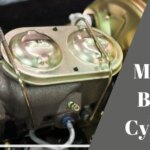
If your automobile battery dies, you can jumpstart it by plugging it into the battery of another vehicle using cables. However, there are times when the strength of a short circuit is so intense that the jumper wires melt before the circuit is completed. When these wires become too hot and begin to melt, they can be extremely frightening and deadly. So, why jumper cables melt?
Simply put, connecting them to the wrong battery terminal is the first and most evident error. Other possible causes are loose connections and improper cable materials.
Table of Contents
Why Jumper Cables Melt?
Cables can melt if they are connected to the wrong battery terminal, for example. Electrical flows could result from a reversed or crossed jumper cable, causing extreme heat on the wires and destroying the cable’s insulation.
The melting of the cables could also be caused by poor connections between the two power sets. Because of resistance to electric flow from one terminal set to another, if the wires are carelessly connected or of poor quality, they may melt. While there are additional causes for jumper cable melting, misaligned or faulty cable connections are the most typical.
What Causes Jumper Cables to Melt?
Let’s take a closer look at the most typical causes of jumper cable melting.
#1 Connection misalignment
A mismatched connection is the most typical cause of melted jumper wires. When attaching jumper cables from one automobile battery to another, be sure the clamps on the cable are linked to the battery’s matching terminals.
The positive post should be clamped by the red cable clamps, while the negative post should be clamped by the black cable clamps. If these are switched backward, the electrical system will collapse and the cables will melt.
Today’s automobiles include safety features that prevent the battery from blowing, instead of frying the jumper cables. It’s important not to rely solely on color to prevent this from happening. Search for the “Plus” and “Minus” signs and match them up. If you’re using a good set of jumper wires, you should be able to charge rather quickly.
#2 Irregular connections
Poor connections at either end could be the reason for the jumper cables melting if you’re using good jumper cables that haven’t been damaged by usage or incorrect storage. When battery connections are loose, their resistance can become so high that heat builds up as the current tries to pass through them.
Short-circuiting can also be caused by loose connections, which produce a lot of heat and can harm your car’s electrical system. When this occurs in close proximity to you, it may produce a burn or shock, as well as set something on fire.
Smacking the terminal connections lightly with your hand is the best approach to check for loose connections. You’ll feel a tiny give once they lock back into place if they’re loose.
#3 Low-cost jumper cable material
Melting could be caused by the metal used in the jumper cable. Most cable manufacturers employ low-cost aluminum to reduce production costs and increase sales. The consumer will be the one to bear the brunt of this. These wires have a weak current connection and are prone to melting. You could use a mix of copper and aluminum to avoid such problems. These cables are high-performing and cost-effective for both the user and the producer.
Aluminum cables should be avoided since they are subject to melting very quickly. Apart from melting, these wires may not make better contact and hence fail to deliver electricity. The thickness of the wire is also important because thinner wires, unlike thicker ones, are prone to melting. Choose high-quality copper starter cables that will not melt under any circumstances.
How to Safely Jump-Start a Car
Follow these procedures to safely jump start your car:
- Get your jumper cables ready.
- Put both automobiles in Park or Neutral and turn off the ignitions in both.
- Activate both parking brakes at the same time.
- Connect one of the red clips to your battery’s positive terminal.
- Connect the other red clip to the other car’s positive terminal.
- Connect one of the black clips to the second battery’s negative terminal.
- The last black clip should be attached to an unpainted metal spot on your car that isn’t near the battery.
- Attempt to start your car.
Conclusion
It is always preferable to prevent rather than cure. Rather than waiting for your wires to melt, take the required safeguards now that you’re aware of the potential reasons. You should learn to jump a car safely and purchase high-quality jumper cables.
Hi there! I’m Naomi O’Colman. I’ve got years of experience working at an auto repair shop here in Texas under my belt. On top of that, ever since I was a kid I’ve been passionate about the auto industry. Since I’ve joined the team at automotivegearz.com I’ve been enthusiastically sharing my passion and insights with my readers. I’m dedicated to delivering high quality content and helping you stay up to date with the latest automotive trends and products out there!







